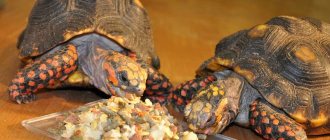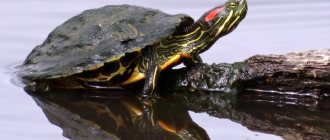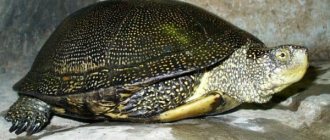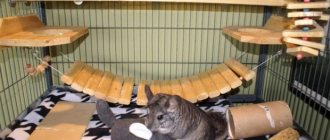The red-eared slider (lat. Trachemys scripta) is the most common among pet turtle lovers. Unfortunately, such popularity also has a downside: a huge number of domestic red-eared turtles are doomed to death or life in unsuitable conditions. Unscrupulous sellers often do not know or hide details from buyers in order to make money. To make this happen less often, we will tell you in detail about the maintenance, feeding and care of this turtle.
Brief introduction
We are all in a hurry, but the article is long and I don’t want to read it. Here's a little introductory note to give you an idea of what the article is all about...
The red-eared slider is very hardy and is a good choice for beginners. On the one hand, they live a long time and often become the first species of turtles for many hobbyists, but on the other hand, people who buy them often destroy them.
They don’t know that turtles need water and land (shore), which should be warm and where UV rays should reach. At the same time, they spend most of their time in water, which must be clean, warm and regularly changed.
As a rule, all problems and diseases are caused by careless owners who do not know that dirty water causes infections; without calcium, the shell will become crooked; without heat and a UV lamp, the turtle does not absorb calcium and gets sick!
They are fast, strong and can be aggressive!
They easily attack other turtles, and each other. They are also known for their personality and charisma, which sets them apart from other turtle species.
They are very skilled when it comes to feeding and can take food from each other.
In the wild, being an invasive species, they displace and destroy endemics so much so that in Australia they are outlawed and exterminated.
Red-eared sliders can make excellent pets, if only because allergies to reptiles are rare.
However, if you decide to have her as a gift for a child, remember that all responsibility for her health and behavior lies with you!
Children cannot care for a turtle at the proper level; moreover, they can quickly lose interest in a new toy and abandon it. And she needs to be fed, water changed, warmed, even washed.
Do you know how long the red-eared turtle lives? With good care, a turtle can live from 20 to 40 years, that is, survive more than one generation of owners.
Habitat in nature
The red-eared freshwater turtle is native to North America and is especially common along the Mississippi River before it flows into the Gulf of Mexico.
She lives in a warm climate in the southern states of the USA, from Colorado to Florida. But its popularity is great and now it is often found in nature around the world, often posing a threat to local fauna.
In its natural habitat, it needs the following conditions: fresh water, places to bask, dense vegetation and for a nest. Usually these are lakes, ponds, swamps, and creeks.
It prefers bodies of water with warm water and a weak current, always with places above the surface of the water where it can climb out to warm itself. Often in such places they lie directly on top of each other. The bottom in such places is usually sandy or silty.
The habitat is usually limited to the water's edge; aquatic turtles do not like to move far from the shore, although females need solid ground to lay eggs.
Small turtles in nature feed on fish, snails, insects and various plants.
Appearance, size, life expectancy
The red-eared turtle is recognizable and difficult to confuse with other species.
A characteristic red (sometimes orange) stripe starts from the eyes and continues along the neck. The carapace (upper part of the shell), round and smooth, is olive green with black and yellow lines.
The plastron (lower part of the shell) is also smooth, yellowish in color with dark spots. Young turtles have a very bright green shell, but it darkens with age.
With age, the spots on the shell darken, and the red stripe on the head turns pale.
The size of a turtle is determined by measuring the length of the shell from edge to edge with a ruler. In this case, they do not pay attention to the curvature of the shell, so it is best to measure with a ruler rather than a tape measure.
Only hatched turtles are about 2.5 cm in length, after a year of life they grow to 5–7 cm. Males become sexually mature at a size of about 10 cm, and females 12.5.
The average size of a turtle is from 25 to 30 cm, depending on the conditions and species. Males are smaller in size than females.
Please note that size cannot be a sign of age. The fact is that at home turtles grow faster than in nature, this is the result of overfeeding and ideal conditions.
But, with proper maintenance and feeding at home, turtles live longer than their wild relatives.
A domestic turtle can live up to 40 years, while a wild turtle can live no more than 20.
Approximate sizes of the red-eared slider by year:
- 1 year: 6 cm.
- 2 years: female - 9 cm, male - 8 cm.
- 3 years: female - 14 cm, male 10 cm.
- 4 years: female - 16 cm, male - 12 cm.
- 5 years: female - 18 cm, male - 14 cm.
- 6 years: female - 20 cm, male - 17 cm.
Sense organs
The red-eared slider has well-developed senses, especially vision and smell. They can distinguish colors both in the water and above it, and can look out for nesting sites for other turtles.
They notice movement very well, at a distance of up to 40 meters, no matter if it is a prey or a predator. They also have a good sense of smell, which helps them find food.
But her hearing is not very good, her ears are covered with skin and feel only dull sounds and vibration. The shell is sensitive to touch because nerves pass through it.
In addition, they have a sense of touch and can reject unpalatable foods in favor of tastier ones.
As for sounds, it can make hissing, snorting, or short sounds like a squeak. Turtles don't breathe underwater, they rise to the surface for oxygen!
How to determine gender?
Just as pet turtles grow faster, they also become sexually mature faster. It becomes sexually mature at the age of one year, and you cannot confidently determine the sex of a turtle if its size is less than 10 cm.
More or less confidently, we can say whether it is a male or a female when the male is 2–4 years old, and the female is 3–5 years old and their size is about 10–15 cm.
True, in the case of abundant feeding, sexual maturity may become earlier.
The main differences between a male and a female are: females are larger and have a shorter tail. In addition, in the female, the cloaca is located closer to the base of the tail. An indirect sign can be the claws on the paws; in males they are longer and curved.
Of even more relative characteristics, the males have a slightly concave plastron inward, which helps him during mating.
Location of the cloaca in a female (right) and male (left)
Appearance
The main part of the body of the red-eared turtle is occupied by a dense shell consisting of horny plates. Its upper part is called the carapace, and the lower part is called the plastron. Limbs, a head and a triangular tail peek out from under the shell. In case of danger, turtles can retract their heads and fold their legs compactly so that the predator cannot grab onto the soft tissue.
The size of an adult turtle can vary from 18 to 30 cm and depends on age, sex and subspecies. Females are noticeably larger than males. Growth rates differ at different periods of life: if young turtles can add 7-8 cm per year, then adult turtles grow by no more than 1.5 cm in 12 months until they reach their maximum size.
Juvenile red-eared turtles have a bright green carapace, which becomes olive or brown with yellow stripe patterns as they age. The head is located on a flexible neck, the pattern on its surface consists of green, black and yellow stripes. Just behind the eyes are two almost oval red or yellow spots. The plastron is bright yellow with green spots.
The reptile's limbs are short, the fingers on each of them end in long claws. The membranes between the toes help turtles swim actively.
Currently, scientists distinguish three subspecies of red-eared turtles, which have slight differences in appearance.
Red-eared turtles can be called long-lived. With proper care, reptiles can live 20-25 years, and some specimens can even reach 40 years.
Turtle at your home
Buying a turtle
So, you have decided to get a red-eared slider. You can simply go to the market or pet store and choose the first one you come across.
Or it can be more difficult, first read, find out, create conditions, buy and take it to the veterinarian. For what? Sellers often keep them in unsuitable conditions, and a veterinarian will check the turtle for wounds, infections, tightness, and disease.
If you already have turtles, then it is best to keep the purchased ones in quarantine for 3 months.
You cannot keep baby and adult turtles together, as this is fraught with accidental and intentional injuries! Only turtles similar in size and living conditions can live together.
After purchasing and changing your place of residence, it may take several days to adapt.
During this time, the turtle can be either inhibited or very active; it is better to leave it alone, but do not forget to feed and look after it.
Handling the turtle
When you pick up a turtle you need to be very careful!
They may be slippery with water, resist, hiss, and have bowel movements. They have sharp claws, powerful paws and they bite painfully, so it is not always pleasant to pick them up.
Try to hold the turtle with both hands! Due to awkward handling, many owners and even more turtles suffered.
After holding the turtle in your hands, wash them with soap! This is especially important for children, since despite the fact that the red-eared turtle is domestic, it lives in a different environment and there are different bacteria there.
It is especially important to keep the aquarium clean and the food fresh, as turtles can carry salmonellosis.
Ideally, any animal in the house should not have access to the kitchen and places where food is prepared. Avoid washing your turtle in the kitchen sink, and do not wash your aquarium or accessories there.
Handling babies
Most turtles appearing in a home aquarium are still babies. They are still very tender and it is important to make sure they eat well and are comfortable.
The cubs have a high mortality rate, are susceptible to disease, and can die for no apparent reason.
If you notice something on your turtle's plastron, it could be the yolk sac.
Newly hatched turtles consume the nutrients from it and it should not be removed or disturbed.
They may refuse food at first, and begin to eat after the yolk sac has completely resolved.
Avoid holding small turtles in your arms. They are, of course, beautiful and elegant, but they can also get scared, get stressed and get sick.
Don't stand over the aquarium or knock on the glass; let them get used to it for a few days and start eating. It is very important that the temperature of water and air (land) be stable.
You cannot place the aquarium in direct sunlight or in a draft. Make sure that she has free access to dry land and that the area is heated with a special lamp.
Keeping temperatures for baby turtles should be slightly higher than for adult turtles! This is 26-27°C for water and up to 32°C for sushi.
The water should be as clean as possible and if there is no good filter, then change it every couple of days.
Feeding is with branded turtle food with calcium, fortunately there is a wide selection of them now. As already stated, do not keep baby and adult turtles together.
Remember, most problems can be avoided simply by creating the necessary conditions.
Fights and aggression
If you consider an aquarium as a small pond, red-eared turtles will exhibit dominant behavior towards others.
They can easily injure others with their claws or bites. Males may chase females, and this often results in severe aggression with biting, severed tails, or death.
Adding a new turtle may provoke fights, especially if the turtles are already sexually mature.
If this happens, significantly increasing the space may help, although it does not guarantee success. Feeding alone (alone outside the aquarium) also reduces aggression.
You can add barriers, plastic plants or walls to prevent the animals from seeing each other.
In general, this is a wild animal by nature, and this behavior is more than normal. If you don't want problems, then you need to keep them alone. Red-eared turtles feel great living without a mate.
Adult turtle and babies - fight for food:
Nursing turtles
After the clutch is laid, the owner needs to transfer it to a special incubator. It could even be a simple three-liter jar of sand. The main thing is to carefully lower the eggs into it and place it in a warm place, for example, near a radiator. The main thing is that the temperature should always be constantly at +25…+30 °C.
Embryos develop in the egg for two to five months. It all depends on the temperature. If it is high, then the rate of turtle maturation increases, but only girls are born.
Males mature at low temperatures and take much longer.
After the babies hatch from the eggs, under no circumstances should they be transplanted into the aquaterrarium with adults in order to avoid cannibalism. They should be grown in a separate tank for at least a year.
Keeping a red-eared turtle
Home care
You understand that prices can vary greatly, so we’ll just list the necessary things:
- Aquarium for turtle 200 liters
- 100 Watt water heater
- Filter (can be internal, but preferably external)
- Ultraviolet lamp for aquatic turtles with UVB 10%
- Heating lamp
- Lamp
- Thermometer
- Land/shore/island
As you can see, the list is quite serious and the most important thing is that all this is really necessary. Now do you understand why so many turtles are dying?
How to care for a red-eared slider?
For almost everyone who wants to get a turtle, the first problem is finding an adequate container and purchasing additional equipment.
And then they begin to understand that the content is more complex than they imagined. And very often, owners simply don’t buy what they need, and then the animal suffers and dies.
Here, even such a simple thing as where to place the terrarium can cause problems. Aquarium from 150 liters, plus water, equipment, shore. The output will be more than three hundred kilograms, and not every table can handle it.
A larger aquarium will allow your aquatic turtle to remain more active and healthy.
Remember - if you keep a turtle in a cramped environment, it will not stay small! This is a common misconception that also applies to aquarium fish and other animals.
She will become sick, twisted, but not small!
What should you buy for your turtle?
So, for maintenance you will need an aquarium or terrarium for the red-eared turtle (or rather an aquaterrarium, since it needs both land and water), from 150 to 200 liters.
When you look at a small turtle, such requirements seem too high, but it will grow up and become much larger.
There should be enough water so that the turtle can turn over freely in it, that is, more than the width of its shell.
You also need artificial land or an island on which the turtle will crawl out and bask.
Such an island can be bought at a pet store; they are specially made. If you decide to do it yourself, then remember that it should be a sloping climb, but one that will be comfortable for the animal to climb.
In principle, that's all that is needed from him.
You can make an island with your own hands; in nature, turtles choose snags, stones, old tires, or any debris sticking out of the water.
But, it is easier to buy a ready-made product, since it must meet certain conditions: not be toxic, be stable, have a textured surface, and not have sharp corners or burrs.
The island must occupy at least 25% of the surface of your aquaterarium and meet the following requirements:
- warming up is the main purpose of the shore for a turtle. The temperature on it should be 10 degrees higher than in the water. Too high a temperature is not good, it can lead to hyperthermia (overheating) in the turtle.
- be semi-submerged, at least one side must be submerged
- be safe so that the turtle does not get stuck between the wall of the aquarium and the shore itself
- do not release toxins when heated and in water
- be stable, since red-eared turtles are quite strong and can turn over the bank
- have a textured surface
Example of an aquaterrarium with a turtle and fish:
Priming
You don’t have to use it at all, like any decor, turtles don’t need it. However, if you want the aquaterrarium to look less dull, then use only large stones.
For example, turtles can swallow gravel and die; besides, the soil makes caring for the aquarium more difficult.
Heating the shore for a turtle
In nature, turtles come ashore to warm themselves, and the same should be done for them in a home terrarium. To achieve the desired temperature of 30-35°C (on the shell), the lamp must be located above the turtle. You will need to look at the thermometer regularly to check the settings.
Be careful as placing a lamp too close can cause burns, especially if you are keeping multiple aquatic turtles as they may climb on top of each other and be closer to the heat source.
Also, do not forget that when turtles dive into the water they raise splashes, and if they hit the base they can easily destroy it, since it is hot. So the lamp for turtles should be closed from water and fumes.
In general, you can buy a suitable lamp at a pet store, especially since they are now sold in pairs with UV lamps, which are needed separately. The heating lamp, like the UV lamp, should work throughout the day, which is 10–12 hours.
Ultraviolet lamp for turtles
Proper lighting and heating are critical aspects of keeping a red-eared slider. In nature, it has enough sunlight and heat to produce all the necessary elements.
But in captivity she lacks neither warmth (we talked about it above) nor spectrum and needs special care. More precisely, UV rays, which are needed so that it can properly absorb calcium and produce B vitamins.
In the absence of a UV lamp in the terrarium, the turtle begins to poorly absorb calcium, which it needs for the normal development of its shell. The result is terrible animals, suffering from rickets, with severely curved shells.
The heating lamp, like the UV lamp, should work throughout the day, which is 10-12 hours.
Moreover, glass or plastic blocks a significant part of the rays and the UV lamp should hang above the turtle. For adult turtles, a lamp with UVB 10% is used.
Aquarium water
Since it is an aquatic species, it spends most of its time in water, so monitoring its quality is very important.
Turtles eat, sleep and defecate in the water, so it needs to be filtered and changed frequently. Dirty water is one of the sources of discomfort, disease and infection.
The minimum water level in the aquarium is such that the turtle could turn over if it suddenly finds itself on its back. That is, no less than the width of its shell.
However, if possible, you should keep it higher, since the more water, the more stable it is and the cleaner it remains. In this case, the turtle must have free access to the shore; it must be able to climb onto it and warm itself at any time.
The water must be left for at least 24 hours so that the chlorine leaves it and it reaches room temperature.
The water temperature in an aquarium with a turtle should be 22-28°C and not fall below 20; if this is possible, then it should be heated using a heater. Be sure to use a thermometer, don't trust your feelings!
The purity of the water is very important, since turtles both eat and defecate in it. Harmful substances such as ammonia and nitrates accumulate very quickly, and the water begins to stink.
To avoid this, change the water in the aquarium once or twice a week. You can also use an internal or external filter, however, this does not replace water changes. For a turtle, internal filters are too low-power, and external filters are good, but quite expensive.
How long can a red-eared turtle live without water if it escapes from the aquarium?
For quite a long time, it happens that they run away from the aquarium and the owners find them only a few days later, lethargic, but alive. In general, she will live quietly for a day or two, but will suffer from drying out.
Purchasing Tips
It is advisable to purchase red-eared turtles in early spring. There will be a summer period ahead, during which it is easy to adapt the kids to new conditions, provide them with walks and exposure to ultraviolet light.
Autumn amphibians tend to adapt less well and grow more slowly. Possible development of pathologies - autominosis, rickets, pneumonia.
It is necessary to choose a healthy individual. The shells must be hard, without chips or signs of deformation. Cracks and spots on the head and skin are unacceptable.
Signs of dehydration include closed or sunken eyes. This is also worth paying attention to. A whitish coating and neoplasms are unacceptable in the mouth. There should be no wounds or signs of injury on any part of the body.
It is unlikely that you will be able to determine the sex of young turtles on your own, but if this question is important, then you can pay attention to the claws, tail and notch on the plastron.
Feeding
Omnivores that feed on a wide variety of foods. Variety is important to keep your turtle healthy.
You can feed: artificial food, food for aquarium fish, vegetables, aquarium plants, insects, fish, invertebrates.
In addition to variety, it is important to provide a balanced diet high in calcium. Like all wild animals that live indoors, there is a tendency to overeat.
Young turtles are mostly omnivores. But as they grow and mature, they become more and more herbivorous.
Omnivorousness means that the diet contains a large amount of protein, but in adult turtles it is much less.
Turtles of any age will prefer live prey or carrion, but should only be fed occasionally. It is also necessary to provide additional calcium for the normal formation and growth of the turtle's shell.
What to feed?
They eat almost everything, but the main food may well be artificial food for aquatic turtles, since there are many options and types. Their composition is specially selected to provide all the necessary substances for turtles. The high protein content of commercial feeds allows them to be fed in small portions.
To make feeding more balanced, add calcium and plant foods and your turtle will be quite happy.
Please note that commercial feeds most often already contain calcium additives; read the labels on the packaging.
Red-eared turtles require water to swallow because they do not produce saliva.
They can take food on land, but will drag it into the water to eat it. You can use this to your advantage and feed them in a separate container, so the water in the aquarium will remain clean for a longer time.
Feeding with plant foods
Fresh vegetables should always be given to your turtle, regardless of whether he shows interest in them or not. A good mix of vegetables contains essential fiber, calcium, vitamins A and K.
Aquarium plants can also be given, especially since they are similar to those that the turtle has in nature.
It is especially important to feed adult and old turtles with plant foods! Their diet should consist of 75% vegetables and aquarium plants.
It can be duckweed, riccia, ludwigia, hornwort, lettuce, pieces of cucumber and zucchini, boiled dandelion and nettle, clumps of filamentous algae.
Live food (guppies, snails)
Omnivores, they happily eat everything they can get their hands on. The turtle's victims will include insects, snails, small fish and worms, crickets, etc.
So the question of whether guppies and red-eared turtles can get along in the same aquarium is not at all worth it. The same can be said about any aquarium fish, even large ones can bite.
Despite the attractiveness and availability of such foods, they should be given in moderation.
It is better to feed special food for turtles, since they are balanced and do not tolerate diseases and parasites.
How much and how often should I feed?
A difficult question, since for the most part it depends on the size, age and the food you give.
Turtles up to one year old need to be fed artificial food daily, and you can also give plant food daily, even if she refuses. But a turtle older than a year can be fed every other day or even two. However, plant foods can again be fed more often.
The amount of food may also vary. Newly hatched turtles should receive more protein, approximately 50% of the total food.
Since most turtle foods contain about 40%, you can additionally feed fish such as guppies, insects, and earthworms.
For adult turtles, the percentage of artificial food is reduced to 10-25%, and the rest should be various plants.
Since the size, shape and composition of feed can vary significantly, you need to focus on what the manufacturer writes on the packaging.
What is the price?
Prices for a red-eared turtle range from 100 to 2500 rubles.
If you are a beginner, you may not be able to cope with several turtles at first, so you should first buy one pet, and after a while another one.
During the warm season, the purchased animal can be carried home in a plastic container or box with sawdust. If it's cold outside, it is recommended to put a heating pad in the box. You can also wrap your pet in a cloth and hide it under a jacket.
Hibernation
Hibernation is the period that a turtle enters during the winter months. There is no need for a pet turtle to hibernate! Moreover, it is not recommended! Never encourage her to do this.
Reasons why hibernation may be unsafe:
- you may not have enough experience to care for her at this time
- Most likely, in order for her to hibernate normally, you don’t have the conditions
- young and sick turtles may be too weak to survive the hibernation period
- your turtle may not need it at all
Turtles hibernating in nature burrow into leaves and silt at the bottom of a reservoir, the depth of which is shallow, and vice versa into the surface.
They do not rise to the surface during this time, but absorb oxygen through membranes in the mouth, pharynx and cloaca. In this case, the depth of the reservoir is important so that the water is not too cold, but also contains enough oxygen.
Most artificial conditions and ponds are unable to recreate these conditions.
In general, a pet turtle should not and should not be hibernated. By the way, the key condition here is the water temperature, it must be maintained at 24-26°C. Lower temperatures just remind her of winter and hibernation.
Natural habitat
It's wide enough. The red-eared slider can be found in many areas of the United States of America - Virginia, Florida, Oklahoma, Kansas, New Mexico, Arizona, North and South Carolina, Georgia, Alabama, Louisiana, Mississippi, Indiana, Illinois, Kentucky. In addition, this amphibian lives in Mexico, Colombia, Venezuela, and many other countries in Central and South America.
Currently, the yellow-bellied turtle has spread widely throughout the world. It can be found in Guadeloupe, Israel, Singapore, Vietnam, South Africa, Japan, Thailand, Malaysia, Hawaii, even in some European countries, such as Spain and England.
In Australia, the red-eared turtle is considered a pest, as it actively eradicates native flora.
In Russia, this species is already found in many ponds in the central part of the country, for example, in the Moscow region (Tsaritsynsky, Kuzminsky, Altufevsky, Dzhamgarovsky).
Thus, this amphibian showed high adaptability to new conditions and survival.
Reproduction
Whether a turtle is sexually mature or not depends on its size. Approximately: 2-4 years for a male and a shell of more than 10 cm and 2-5 years for a female and 12-13 cm.
Mating games begin with a sexually mature male (although young ones can also try), with a kind of courtship. During which he swims in front of the female, with his muzzle towards her and waves his paws very quickly in front of her eyes.
In nature, breeding occurs in March and June, but domestic turtles can mate throughout the year.
When a turtle is pregnant, that is, carrying eggs, you need to prepare a special place for her where she will lay these eggs. A female can carry eggs without a male, but they will not be fertilized!
You can gently feel the eggs between the carapace and her hind legs, but be careful, they are very fragile. The female will instinctively look for a place to nest and lay eggs.
A clutch can contain up to 20 eggs for a large female. If the conditions are suitable, then the female lays up to 3-4 clutches per season.
In a home aquaterrarium, the female signals preparation for reproduction by changing her behavior.
She becomes very restless, imitates digging movements with her hind legs and tries to get out of the aquarium. Also during this time, she spends more time on land and needs calcium and UV rays.
The place where she can lay her eggs is very important; if there is not one, she will lay them in the water or even carry them further, which will cause them to harden.
If you see that a turtle has laid one or two eggs, try to make a nest for it. Most likely, the rest of the clutch has not yet hatched and she is still pregnant.
If the female does not lay eggs, they will harden and can cause infection and death of the animal.
Even a properly prepared nest is not a guarantee that everything will go well, since the turtle may be old, tired, or sick.
If she tries to lay her clutch, but nothing works, then it is better to take her to the veterinarian.
Possible signs of problems: decreased activity, heavy breathing, depressions or swelling near the cloaca.
If there is an unpleasant liquid coming out of it or there is an odor, then the eggs inside may have broken. If you have any health problems with your red-eared slider, contact your veterinarian immediately!
Breeding
Reptiles reach sexual maturity at different ages; the process is influenced by the sex of the animal and lifestyle. If they live in an aquaterrarium, then females reach sexual maturity by 5-6 years, males by 4 years. In nature, turtles mature only at 8 years of age. The “wedding” period for reptiles occurs in the first spring months. The male approaches the female he likes, pokes his muzzle into her and begins to tickle her chin with his claws.
The female lays her eggs on land, in an area that she first prepares: she moistens it with water from her own anal bladder and digs a hole. The clutch consists of 5-10 eggs, the size of which is no more than 4 cm. When the laying process is completed, the female carefully buries the future offspring.
The incubation period is long and lasts up to 21.5 weeks. An interesting fact is that the sex of hatching turtles depends on the temperature: if the indicator remains above 30°C, then females appear, and if below 27°C, then males.
Health and illness
More than 85% of all diseases of red-eared turtles are the result of improper care, maintenance and feeding, and most often all at once.
Maintaining clean water and the right temperature for your pet is as easy as creating the right conditions.
Here are the basics to help you keep your turtle healthy:
- Sick turtles should be kept at a higher temperature, in most cases 27-30 Celsius. At this temperature, the immune system operates at its peak efficiency. It is important to maintain fluid balance in the turtle's body so that it does not become dehydrated. Ensuring that she drinks and is in water is more important than her nutrition, since a sick turtle can die from dehydration and its kidneys will fail. Even in emaciated turtles, fluid balance is first restored, and then feeding begins.
- A sick turtle swims poorly, swims on one side, and may even drown. Reduce the water level and make sure she can come ashore as soon as she wants.
- If you suspect an infection, immediately isolate the animal and be sure to wash your hands after handling it.
- The basis for success in treating a turtle is contacting a specialist. Do not treat the animal yourself, go to the veterinarian!
Where does it live?
The red-eared slider's historical range includes a wide area from the southern United States to northern Colombia and Venezuela. Reptiles prefer shallow lakes, small ponds without steep banks. Turtles lead a sedentary lifestyle: they either leisurely look for their next prey, swimming in a pond, or, having had their fill, crawl ashore and bask in the sun. If danger is detected, turtles suddenly take off and dive into the water.
The high endurance of red-eared turtles led to the fact that they were artificially introduced to the countries of Europe, Southeast Asia, Japan, China, and South Africa. In Australia, reptiles are officially recognized as pests, since they successfully compete with the local endemic reptofauna and displace them from their usual habitats. Unfortunately, red-eared turtles can increasingly be found in urban ponds in our country; most of them were released by their owners.
Sense organs
This animal is distinguished by a high level of development of sensory organs. The main features are as follows:
- Vision. Red-eared turtles distinguish colors, choose the most suitable places to lay eggs, and look for other turtles. They also see moving objects, the distance to which can reach 40 m, well distinguishing predators and prey from each other.
- Smell. These reptiles search for food thanks to their developed sense of smell.
- Hearing. These animals hear poorly. This is due to the fact that their ears are hidden under the skin. Therefore, red-eared turtles react only to vibration.
- Touch. The turtle's shell is equipped with nerve endings, so it feels touch. The presence of taste buds allows these creatures to choose tastier foods.
- Voice. The vocal apparatus of turtles is not developed; they are only capable of snorting and hissing. Sometimes they make a squeak.
Cleaning
The most unpleasant and difficult thing. During harvesting, the turtle must be transplanted into a specially equipped fish tank (there can be only one tank for feeding and temporary housing at the time of harvesting).
Cleaning is done once a week. In our case, a full treatment of algae and bacteria using antiseptics is required, followed by rinsing under running water. Chlorhexidine, sold at any pharmacy, is suitable as an antiseptic, or you can use a weak soap solution. During cleaning, do not forget to thoroughly treat each wall and all corners of the aquaterrarium.
Remember: provided that the aquaterrarium is thoroughly cleaned weekly, the likelihood of your turtle developing skin problems will be extremely, extremely low.











